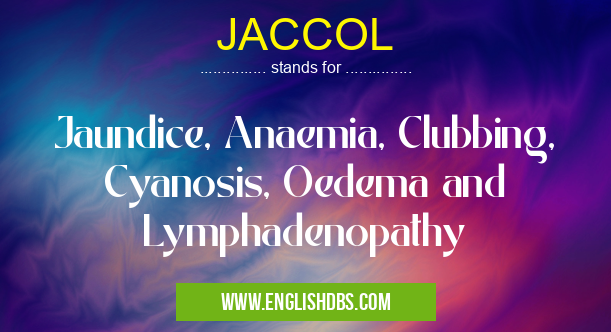What does JACCOL mean in MEDICAL
JACCOL stands for Jaundice, Anaemia, Clubbing, Cyanosis, Oedema and Lymphadenopathy. These are all symptoms of certain medical conditions or diseases that can be observed by healthcare providers in patients who may have a wide variety of illnesses. In order to understand the implications of JACCOL, it is important to understand the definition and characteristics of each term.

JACCOL meaning in Medical in Medical
JACCOL mostly used in an acronym Medical in Category Medical that means Jaundice, Anaemia, Clubbing, Cyanosis, Oedema and Lymphadenopathy
Shorthand: JACCOL,
Full Form: Jaundice, Anaemia, Clubbing, Cyanosis, Oedema and Lymphadenopathy
For more information of "Jaundice, Anaemia, Clubbing, Cyanosis, Oedema and Lymphadenopathy", see the section below.
Essential Questions and Answers on Jaundice, Anaemia, Clubbing, Cyanosis, Oedema and Lymphadenopathy in "MEDICAL»MEDICAL"
What is jaundice?
Jaundice is a yellowing in the skin and eyes that can result from an increase in bilirubin levels due to liver or red blood cell damage. It can be caused by a variety of illnesses such as hepatitis, gallbladder disease and cancer.
What is anaemia?
Anaemia is a decrease in red blood cells or haemoglobin levels which can lead to increased fatigue or paleness of the skin. It can also result from lack of iron intake or heavy menstrual bleeding.
What is clubbing?
Clubbing is observed in the fingers and toes when there are changes in the shape of their tips due to an increase in tissue on them. It's usually associated with conditions related to impaired oxygenation such as chronic lung disease or heart failure.
What is cyanosis?
Cyanosis is blue-tinged skin resulting from insufficient oxygenation that may be caused by several conditions including congenital heart defects, respiratory issues and asthma attacks.
Final Words:
The six terms included in JACCOL represent a range of symptoms that can help health care providers diagnose certain medical conditions more accurately and quickly. Understanding what each symptom means and how it relates to diagnosis can help both patients and professionals make informed decisions about treatment options available.
